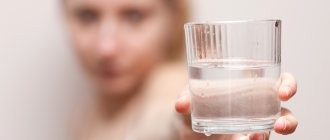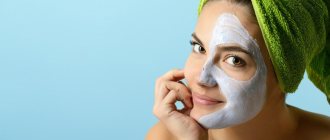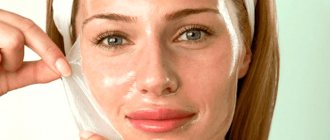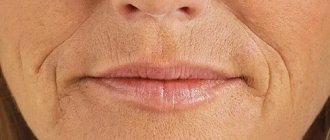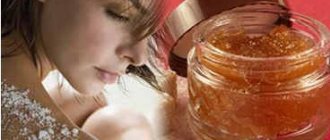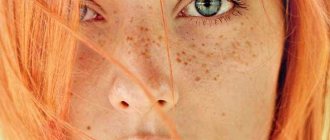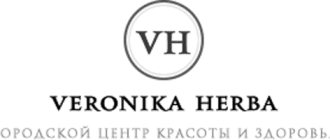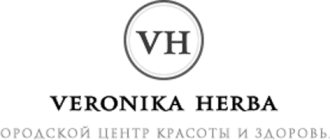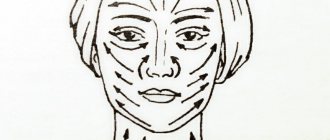Signs of oily skin
A well-known way to determine your skin type is as follows: immediately after waking up, you need to blot your face with a paper napkin. The appearance of a stain on it indicates increased fat content. The following symptoms will help confirm this guess:
- the presence of an oily sheen;
- enlarged pores;
- periodic blackheads and other rashes;
- a feeling of “heaviness” of the face within a couple of hours after washing.
In adolescence, such symptoms are very common: to one degree or another, they are present in almost every young man or girl. However, as we grow older, increased activity of the sebaceous glands often persists.
Oily skin problems
Enlarged pores
Pores become enlarged due to excessive secretion of the sebaceous glands. As a rule, this occurs in the forehead and nose area, less often in the cheek area. Having expanded during adolescence, if left untreated, the pores remain that way for life.
Black dots
Blackheads are open comedones that clog pores. Their contents are a plug, compressed from epithelial cells and excess fat. When you press on the blackheads, they separate, but there is a risk of small scars.
Acne
These are spots on the surface of the skin indicating inflammation. Acne can be of different colors and types (papular, pustular, tuberous, etc.).
Acne
This name is often used as a synonym for acne, which is characterized by disruption of the sebaceous glands and can form entire islands of inflammation.
Clogged pores
Clogged pores are a consequence of their excessive expansion. This problem interferes with normal skin breathing and provokes the appearance of rashes.
Causes
“Why do I have oily skin?” — clients ask cosmetologists this question quite often. Increased activity of the sebaceous glands is caused by the following reasons:
- genetic predisposition;
- hormonal changes
- systematic improper facial care;
- gastrointestinal or liver diseases;
- endocrine disorders;
- errors in nutrition (a very large amount of flour products, sweet, spicy or fatty foods in the diet);
- taking hormonal medications or drugs that affect the activity of the sebaceous glands;
- frequent stress.
How to get rid of oily shine?
Coping with oily shine on the face is a completely doable task. Following these recommendations will be of great help in this regard:
- Matting napkins. You should not remove oily shine with powder, because under it the skin cells begin to work more actively and after a few minutes the oiliness will appear again. When using mattifying wipes, you get a “blotter” effect that evens out your skin tone and doesn’t clog your pores even more.
- Wash less often. Oily skin really needs constant cleansing, but you shouldn't go to extremes. With constant washing, and even using gels, the skin begins to dry out and this provokes more frequent secretion of sebum. It will be enough to wash your face 2-3 times a day.
- Use masks made from natural ingredients.
- A clay mask has proven itself well. It does not require any additions and perfectly mattifies the skin. It is advisable to apply the mask after washing your face in the morning, but before using toner. Many people prefer masks made from kefir, which can dry out and whiten the skin. You can mix kefir with oatmeal and massage the skin.
- Masks using fresh vegetables will also be beneficial. The most commonly used are cucumbers and potato juice. Their recipe may include both egg white and various essential oils, which together rejuvenate the skin and reduce oily shine.
- Cosmetology procedures. Peels, ultrasonic cleansing, and mesotherapy are effective for oily skin.
Sometimes oily shine on the skin of the face causes significant problems with self-confidence. Those with problem skin feel best in winter. With the onset of cold days, the activity of the sebaceous glands decreases, and oily skin becomes closer to combination skin. In any case, you should pay special attention to caring for your face and reduce the risk of harmful effects.
Oily skin: what to do
The following procedures will help get rid of problems and restore your face to a healthy appearance:
Peeling
Salon peeling allows you to get rid of dead particles of epithelium and activate cell renewal processes; Provides complete cleansing and reduction of pores. There are several types of peeling, differing in depth and mechanisms of action. A cosmetologist will help you choose the best option depending on the individual characteristics of the body.
Cleaning
Professional cleansing is a truly necessary procedure for those with oily skin. To minimize the likelihood of damage occurring during it, Novoklinik specialists recommend a special technique: Holy Land atraumatic cleansing, which is suitable even for sensitive skin. It lasts no more than 40 minutes and is carried out using hypoallergenic cosmetics made from natural ingredients.
It should be understood that if increased activity of the sebaceous glands is observed as a result of a particular disease, even the most effective cosmetic procedures will lead only to temporary improvement. Only comprehensive treatment will guarantee lasting results.
More about procedures
Jessner Peel
Face cleaning
Atraumatic cleaning
What aesthetic problems bother women during this period?
Formation and deepening of static wrinkles
With menopausal aging, pronounced changes occur in the dermis, where there is a decrease in the number of fibroblasts and a decrease in their functional activity, a decrease in the concentration of glycosaminoglycans (hyaluronic acid, etc.). Collagen fibers undergo dystrophic changes; they become denser and rougher. A decrease in the elasticity of collagen fibers and their ability to swell is the reason for persistent imprinting of the pillow on the face after sleep. Injection of biotechnologically obtained hyaluronic acid is indicated for all patients with reduced skin turgor. The following drugs for biorevitalization have proven themselves well: Ial-System, Viscoderm, Achyal, Surglift plus, Teosyal MesoExpert. In the spring of 2010, a new injection drug appeared, intended for skin rejuvenation after 40-45 years, Meso-Wharton P 199 (Mezovarton). The mechanism of its action is associated with the activation of the proliferation of the skin’s own stem cells and the restoration of the intercellular matrix. After a course of procedures, the skin texture is noticeably smoothed, the oval of the face is tightened, and the level of hydration increases. Meso-Wharton P 199 is indispensable in the recovery period after laser facial rejuvenation and midline peels in menopausal women. Of the mesotherapy drugs, the drug Dermaheal HSR deserves attention - an anti-aging cocktail with 1% hyaluronic acid containing EGF (epidermal growth factor), IGF-1 (insulin-like growth factor), b-FGF (beta fibroblast growth factor), TRX (Thioredoxin), copper tripeptide-1, 14 vitamins, 24 amino acids and minerals. The course ranges from 4 to 8 procedures once every 2 weeks. The visible effect occurs 6-7 days after the procedure. After a course of procedures, the quality of the skin improves significantly.
To fill static wrinkles, contour plastic surgery based on stabilized hyaluronic acid is widely used. Commercial names of the drugs: Restylane, Juvederm, Surgiderm (Surzhiderm, Surzhiderm), Teosyal, Belotero. They are safe and have a huge number of positive reviews all over the world.
Facial oval deformation
Gravitational ptosis - pronounced sagging of the skin under the influence of gravity - is formed as a result of involutional changes in the underlying structures (fascia, muscles, ligaments). RF lifting or thermolifting using the Reaction device is the No. 1 procedure in correcting facial oval deformities. The procedure is non-invasive and virtually painless, well tolerated, and no rehabilitation period is required. The effectiveness of the procedure depends on the selected parameters, which are selected strictly individually by the doctor during consultation.
Increased skin sensitivity
Patients are often concerned about dryness and tightness of the skin, fine-plate peeling, and increased sensitivity to cold, detergents, and cosmetics. With minor trauma, wounds appear that take a long time to heal. This is due to a decrease in the protective properties of the skin (changes in the lipid barrier of the epidermis and the natural moisturizing factor complex), as well as an increase in the synthesis of pro-inflammatory cytokines, which play an important role in the development of some dermatitis. A consequence of the aging of the skin's immune system is low resistance to infectious agents, especially viruses and fungi. An important element of caring for sensitive skin is corneotherapy - restoration of the full stratum corneum of the skin. For this purpose, drugs from the CoCo dermatological line (Germany) are used. The system of individual formulations allows you to create a large number of compositions not only for complete care of sensitive skin, but also for the correction of age-related skin changes during menopausal aging.
Acne
Greasy shine, enlarged pores, inflammatory elements in the T-zone - a typical picture of late-type acne in premenopausal women. Against the background of a gradual decrease in the level of estrogens, which have antiandrogenic activity, relative hyperandrogenism develops and, as a consequence, increased activity of the sebaceous glands. Changes in the composition of sebum and the rate of its production predispose to the development of seborrhea. The tactics for managing patients with acne during menopause are practically no different from traditional therapy. Good results were obtained when using photorejuvenation in the treatment of late acne using the Ellipse Multi Flex device. It is based on the principle of selective absorption of light by chromophores with their subsequent heating and destruction. Chromophores in the treatment of acne are porphyrins of pyogenic bacteria and melanin. When light energy is absorbed, the skin is sanitized, acute and chronic inflammatory processes are stopped, and post-inflammatory hyperpigmentation is eliminated. The course of phototherapy for acne is 3-6 procedures with an interval of 1-2 weeks.
The condition of the skin improves significantly when a gynecologist prescribes hormone replacement therapy.
Male-type facial hair growth (above the upper lip, along the oval of the face)
This is also associated with the development of relative hyperandrogenism during premenopause. The vellus hair above the upper lip becomes pigmented. To remove unwanted hair, photoepilation using the Ellipse Multi Flex device is successfully used. The mechanism is based on photothermal damage to the main structural elements of the hair follicle. The interval between procedures is 3-4 weeks, sometimes less. Electrolysis in this anatomical area is not indicated due to the risk of scarring and post-inflammatory hyperpigmentation, especially in women with phototype III. Bioepilation with wax is also not recommended, as it can provoke increased hair growth.
Male pattern hair loss (formation of bald patches on the forehead and thinning hair in the parietal area)
Most often, patients note the following symptoms in the frontoparietal region: hair thinning, replacement of long hair with shorter ones, loss of pigment and thinning hair. Sometimes the thinning process is diffuse in nature, as a result of which the shaft hair turns into vellus hair, the hair follicle gradually atrophies and the hair eventually falls out. All this is combined with hyperproduction of sebum, which forces women to wash their hair more often.
The most effective method of solving problems of the scalp and hair is the administration of drugs using mesotherapy. The effectiveness of mesotherapy is due not only to the pharmacological effect of the administered drugs, but also to the stimulation of nerve endings. The main course of mesotherapy is 6-12 procedures once a week. An integrated approach allows you not only to stop hair loss, but also to restore lost volume. Along with mesotherapy, drugs are prescribed that normalize hair growth, one of them is Pantovigar. Its patented formula allows you to supply the hair follicle cells with all the necessary nutrients, which ensures a pronounced restoration of the hair structure.
Telangiectasia
The dilation of the veins due to the thinning of their walls is accompanied by the formation of single telangiectasia in the area of the cheeks and wings of the nose. The method of choice for vascular removal is phototherapy of vascular formations on the face using the Ellipse Multi Flex device. The chromophore in this case is hemoglobin. During the procedure, the vessel coagulates and, depending on the depth and diameter, the vessel disappears immediately or changes color and disappears over time.
Care for oily skin
Proper home care for problem skin involves regular cleansing, toning, relieving inflammation and nutrition. That is why your home medicine cabinet must contain antiseptic preparations, cleansing tonics, washing gels, masks and scrubs. A cosmetologist will help you choose products that are ideally suited and, most importantly, that do not cause allergic reactions.
People with oily skin should wash their face at least twice a day, remove makeup from their face promptly, and also monitor their diet and minimize the likelihood of stress. If these conditions are strictly followed, the incidence of acne, blackheads or clogged pores will be minimized.
Cosmetic procedures are contraindicated during pregnancy and lactation.
